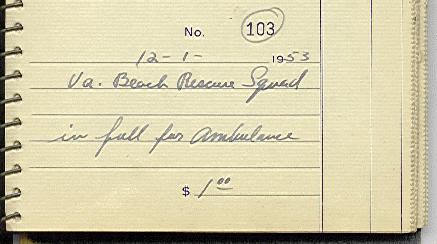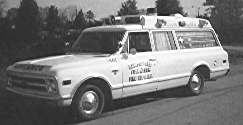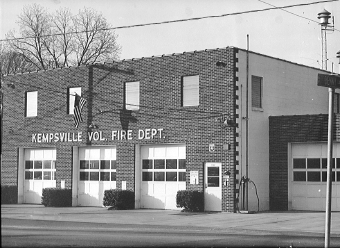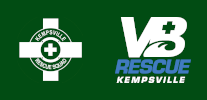In 1950, a group of Kempsville residents, most of whom were members of the local Amish-Mennonite community, chartered the Kempsville Volunteer Fire Department. Within three years, the firefighters had purchased their first ambulance for the sum of one dollar from the rescue squad that had just formed in the distant town of Virginia Beach (now the resort strip area).


Kempsville’s first real fire station was built in 1956. Our charter members told of days when the wail of the station siren alerted them to emergencies. One cycle for an ambulance call, two for a fire call, three for a motor vehicle crash. When the siren wailed, a relay activated the truck radios so their tubes would warm up by the time the drivers arrived. Firefighters riding the engine’s tailboard would toss bags of chalk onto the ground at every turn, so that other responders would know how to get to the scene. The station siren was phased out in the 70’s, as pagers became more affordable.
(Unless otherwise noted, photos on this page are from 1963, on the occasion of the delivery of a new fire truck.)
By 1967, rescue calls were outnumbering fire calls, and a charter was drawn up for a spin-off company called the Kempsville Rescue Squad. The two all-volunteer companies operated as a partnership for thirty years.
Unit 901, a 1968 Chevy Custom Ambulance, was retired in 1971 with 36,500 miles on its odometer.
Also in the mid 70’s, progressive members of the city’s several rescue squads had secured a federal grant to develop an advanced life support capability for their organizations. The Emergency Coronary Care Program, as it was known, led to the establishment of the Council of Virginia Beach Volunteer Rescue Squads, Inc., and the municipal Department of Emergency Medical Services. Both agencies, as well as KVRS and the other independent rescue squad corporations, are now recognized in city code as official components of the city’s emergency services.


In the late 70’s and throughout the 80’s, Kempsville was the fastest growing borough in the city. The phenomenal growth took its toll on the Kempsville Volunteer Fire Department, and taxed the Kempsville Rescue Squad to its limits.
The next Unit 901 and its sibling, Unit 903 were 1971 Ford F350 Sports Custom chassis with Swab Modular Compact boxes. Note the introduction of the green stripe and the logo. KVRS has stuck with modular ambulances and the logo ever since.
When the fire department and rescue squad moved into a new city building in 1982, the old building escaped destruction to become the Hagan’s Seafood Restaurant and then the Harmon Glass store. In 2010, the station built in 1956 was demolished during the relocation of Kempsville’s historic central intersection — where Kempsville, Princess Anne, and Witchduck Roads met.


On July 1st, 1997, the squad absorbed the Kempsville Volunteer Fire Department, and focused its mission sharply on EMS, rescue, and support services.
In 1998, the Lake Gaston Water Supply Pipeline was put into service, allowing residential and business development in Virginia Beach to proceed at a new order of magnitude. This once again caused dramatic change to the character of the Kempsville area and to the city, and propelled demand for EMS services much higher. The extent of the Virginia Beach Fire Department’s participation in EMS first-response and in rescue services became more substantial, and in 2004 the Virginia Beach EMS Department hired its first set of paid response medics to augment — but not replace — the manpower provided by KVRS and its sister squads.
The COVID-19 pandemic that began in 2020 initially caused much uncertainty about KVRS’s ability to retain its volunteers and to continue recruiting new ones. Although the pandemic did partially motivate the city to hire even more paid response medics, the squad’s roster only seemed to shrink by about 10%. The contraction stemmed primarily from employers who discouraged their employees from “running rescue” rather than from any decline in member interest or dedication. Both the EMS Department and KVRS gave special attention to making sure volunteer responders were protected from infection.
KVRS remains vibrant and agile. The squad’s long-term vision statement is a reflection of its past, with the flexibility to allow the squad to change its shorter-term mission to fit the times.

